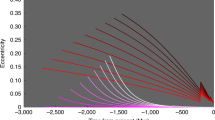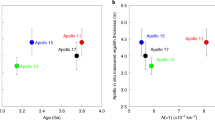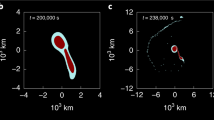Abstract
The Martian moons Phobos and Deimos may have accreted from a ring of impact debris, but explaining their origin from a single giant impact has proven difficult. One clue may lie in the orbit of Phobos that is slowly decaying as the satellite undergoes tidal interactions with Mars. In about 70 million years, Phobos is predicted to reach the location of tidal breakup and break apart to form a new ring around the planet. Here we use numerical simulations to suggest that the resulting ring will viscously spread to eventually deposit about 80% of debris onto Mars; the remaining 20% of debris will accrete into a new generation of satellites. Furthermore, we propose that this process has occurred repeatedly throughout Martian history. In our simulations, beginning with a large satellite formed after a giant impact with early Mars, we find that between three and seven ring–satellite cycles over the past 4.3 billion years can explain Phobos and Deimos as they are observed today. Such a scenario implies the deposition of significant ring material onto Mars during each cycle. We hypothesize that some anomalous sedimentary deposits observed on Mars may be linked to these periodic episodes of ring deposition.
This is a preview of subscription content, access via your institution
Access options
Access Nature and 54 other Nature Portfolio journals
Get Nature+, our best-value online-access subscription
$29.99 / 30 days
cancel any time
Subscribe to this journal
Receive 12 print issues and online access
$259.00 per year
only $21.58 per issue
Buy this article
- Purchase on Springer Link
- Instant access to full article PDF
Prices may be subject to local taxes which are calculated during checkout


Similar content being viewed by others
References
Rivkin, A. Near-infrared spectrophotometry of Phobos and Deimos. Icarus 156, 64–75 (2002).
Burns, J. A. in Mars (eds Kieffer, H. H., Jakowsky, B. M., Snyder, C. W. & Matthews, M. S.) 1283–1301 (Univ. Arizona Press, 1992).
Cameron, A. G. W. & Ward, W. R. The origin of the Moon. In Abstr. Lunar Planet. Sci. Conf. Vol. 7 120–122 (1976).
Charnoz, S., Salmon, J. & Crida, A. The recent formation of Saturn’s moonlets from viscous spreading of the main rings. Nature 465, 752–754 (2010).
Crida, A. & Charnoz, S. Formation of regular satellites from ancient massive rings in the solar system. Science 338, 1196–1199 (2012).
Craddock, R. A. Are Phobos and Deimos the result of a giant impact? Icarus 211, 1150–1161 (2011).
Rosenblatt, P. & Charnoz, S. On the formation of the Martian moons from a circum-Martian accretion disk. Icarus 221, 806–815 (2012).
Citron, R. I., Genda, H. & Ida, S. Formation of Phobos and Deimos via a giant impact. Icarus 252, 334–338 (2015).
Canup, R. M. & Salmon, J. On an origin of Phobos-Deimos by giant impact. In 47th Lunar Planet. Sci. Conf. Abstr. 2598 (2016).
Leone, G., Tackley, P. J., Gerya, T. V., May, D. A. & Zhu, G. Three-dimensional simulations of the southern polar giant impact hypothesis for the origin of the Martian dichotomy. Geophys. Res. Lett. 8736–8743 (2014).
Nimmo, F., Hart, S. D., Korycansky, D. G. & Agnor, C. B. Implications of an impact origin for the Martian hemispheric dichotomy. Nature 453, 1220–1223 (2008).
Andrews-Hanna, J. C., Zuber, M. T. & Banerdt, W. B. The Borealis basin and the origin of the Martian crustal dichotomy. Nature 453, 1212–1215 (2008).
Marinova, M. M., Aharonson, O. & Asphaug, E. I. Mega-impact formation of the Mars hemispheric dichotomy. Nature 453, 1216–1219 (2008).
Marinova, M. M., Aharonson, O. & Asphaug, E. Geophysical consequences of planetary-scale impacts into a Mars-like planet. Icarus 211, 960–985 (2011).
Murray, C. D. & Dermott, S. F. Solar System Dynamics (Cambridge Univ. Press, 1999).
Black, B. A. & Mittal, T. The demise of Phobos and development of a Martian ring system. Nat. Geosci. 8, 913–917 (2015).
Rosenblatt, P. et al. Accretion of Phobos and Deimos in an extended debris disc stirred by transient moons. Nat. Geosci. 9, 581–583 (2016).
Yoder, C. F. Tidal rigidity of Phobos. Icarus 49, 327–346 (1982).
Scheeres, D. J., Hartzell, C. M., Sánchez, P. & Swift, M. Scaling forces to asteroid surfaces: the role of cohesion. Icarus 210, 968–984 (2010).
Kite, E. S., Halevy, I., Kahre, M. A., Wolff, M. J. & Manga, M. Seasonal melting and the formation of sedimentary rocks on Mars, with predictions for the Gale Crater mound. Icarus 223, 181–210 (2013).
Hurford, T. A. et al. Tidal disruption of Phobos as the cause of surface fractures. J. Geophys. Res. Planet. 121, 1054–1065 (2016).
Werner, S. C. & Tanaka, K. L. Redefinition of the crater-density and absolute-age boundaries for the chronostratigraphic system of Mars. Icarus 215, 603–607 (2011).
Salmon, J., Charnoz, S., Crida, A. & Brahic, A. Long-term and large-scale viscous evolution of dense planetary rings. Icarus 209, 771–785 (2010).
Bath, G. T. & Pringle, J. E. The evolution of viscous discs - I. Mass transfer variations. R. Astron. Soc. 194, 967–986 (1981).
Toomre, A. On the gravitational stability of a disk of stars. Astrophys. J. 139, 1217–1238 (1964).
Anderson, J. D. Jr Computational Fluid Dynamics (McGraw-Hill, 1995).
Duncan, M. J., Levison, H. F. & Lee, M. H. A Multiple time step symplectic algorithm for integrating close encounters. Astron. J. 116, 2067–2077 (1998).
Takeuchi, T., Miyama, S. M. & Lin, D. N. C. Gap formation in protoplanetary disks. Astrophys. J. 460, 832–847 (1996).
Esposito, L. Planetary Rings (Cambridge Univ. Press, 2006).
Goldreich, P. & Tremaine, S. The excitation of density waves at the Lindblad and corotation resonances by an external potential. Astrophys J. 233, 857–871 (1979).
Meyer-Vernet, N. & Sicardy, B. On the physics of resonant disk-satellite interaction. Icarus 69, 157–175 (1987).
Acknowledgements
The authors would like to thank B. Horgan, M. Ćuk, E. Asphaug, A. Jackson and K. Walsh for their advice and support. A.J.H. was supported under the NASA Earth and Space Science Fellowship: 16-PLANET16F-0127. D.A.M. was supported under the NASA Emerging Worlds Grant: NNX16AI31G.
Author information
Authors and Affiliations
Contributions
Both A.J.H. and D.A.M. designed the study, discussed the results, and wrote the paper. A.J.H. developed the computer model, performed the simulations, analysed the results, and produced the tables and figures.
Corresponding author
Ethics declarations
Competing interests
The authors declare no competing financial interests.
Supplementary information
Supplementary Information
Supplementary Information (PDF 526 kb)
Rights and permissions
About this article
Cite this article
Hesselbrock, A., Minton, D. An ongoing satellite–ring cycle of Mars and the origins of Phobos and Deimos. Nature Geosci 10, 266–269 (2017). https://doi.org/10.1038/ngeo2916
Received:
Accepted:
Published:
Issue Date:
DOI: https://doi.org/10.1038/ngeo2916
This article is cited by
-
Martian moons exploration MMX: sample return mission to Phobos elucidating formation processes of habitable planets
Earth, Planets and Space (2022)
-
The large obliquity of Saturn explained by the fast migration of Titan
Nature Astronomy (2021)
-
Dynamical evidence for Phobos and Deimos as remnants of a disrupted common progenitor
Nature Astronomy (2021)
-
The Origins and Geological Histories of Deimos and Phobos: Hypotheses and Open Questions
Space Science Reviews (2021)
-
MIRS: an imaging spectrometer for the MMX mission
Earth, Planets and Space (2021)



